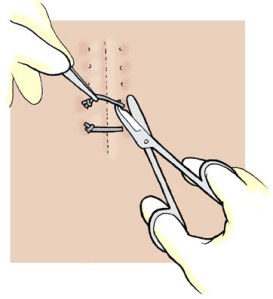
IV Drip. The solution (fluid) travels from the bag through the tube to the patient’s body. A needle is inserted (put) into a vein with a needle.

Injection. Another way of getting some solution into a patient’s body: by injection.

The barrel of a syringe usually has measurements or calibrations on it.

You use a syringe to give an injection. You have to be careful to read the calibrations and think about the time it takes you to administer (give) the injection.

You don’t always give injections with syringes. You can also take blood from a patient.

Stitches. Needles are also used to put in stitches (sutures).

A healthcare professional takes out (removes) stitches when the wound has healed. Normally this is after about ten to fourteen days. She uses tweezers to pull the stitch up a little then she cuts the stitch. Then the stitch can be pulled out safely.


